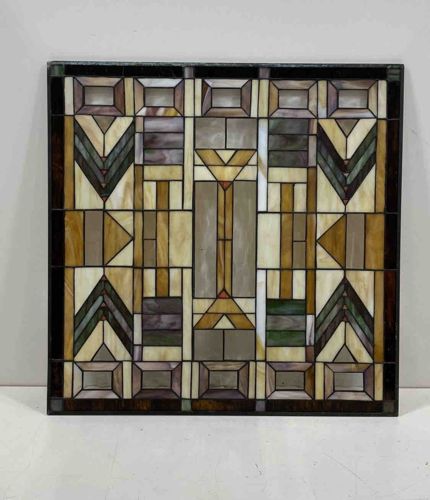
Arts and Crafts Style Geometric Stained Glass Panel
This item is a rectangular stained glass panel, likely designed as an insert for a window, door, or cabinet. Its dimensions appear to be roughly square, or close to it, suitable for a larger architectural feature. The panel is constructed from numerous individual pieces of art glass, meticulously cut and joined together with lead came, characteristic of traditional stained glass fabrication methods. The color palette is predominantly earthy and muted, featuring various shades of amber, gold, beige, cream, brown, and subtle hints of variegated greens and purples. The glass itself exhibits different levels of opacity and texture, including some pieces that appear to be streaky or mottled (opalescent glass common in the Arts and Crafts period), providing visual depth and light diffusion rather than clear transparency. The design is abstract and geometric, highly reminiscent of the Arts and Crafts or Mission style, particularly influenced by figures like Frank Lloyd Wright's Prairie School architecture. It features a strong use of horizontal and vertical lines, with repeating rectangular and square forms. Notable features include chevron or 'V' shaped motifs in darker green and purple tones at the corners and along the sides, which create a sense of movement and architectural stability. A central vertical element is prominent, composed of elongated rectangular glass pieces. The lead lines are dark, providing a strong graphic outline to each glass segment. The overall condition appears to be good for its age, though close inspection would be needed to identify any hairline cracks in the glass, bent lead came, or signs of detachment. Patina is visible on the lead, suggesting age and natural oxidation. There are no discernible maker's marks or signatures visible in the provided image. The deliberate use of geometric patterns, earthy colors, and substantial lead work strongly points to a style period roughly between the late 19th century and the first quarter of the 20th century, typically 1890s-1920s.
AI-Generated Appraisal Disclaimer
Estimated Value
$1,800 - $2,500
Basic Information
Category
Art Glass/Architectural Element
Appraised On
November 28, 2025
Estimated Value
$1,800 - $2,500
Item Description
This item is a rectangular stained glass panel, likely designed as an insert for a window, door, or cabinet. Its dimensions appear to be roughly square, or close to it, suitable for a larger architectural feature. The panel is constructed from numerous individual pieces of art glass, meticulously cut and joined together with lead came, characteristic of traditional stained glass fabrication methods. The color palette is predominantly earthy and muted, featuring various shades of amber, gold, beige, cream, brown, and subtle hints of variegated greens and purples. The glass itself exhibits different levels of opacity and texture, including some pieces that appear to be streaky or mottled (opalescent glass common in the Arts and Crafts period), providing visual depth and light diffusion rather than clear transparency. The design is abstract and geometric, highly reminiscent of the Arts and Crafts or Mission style, particularly influenced by figures like Frank Lloyd Wright's Prairie School architecture. It features a strong use of horizontal and vertical lines, with repeating rectangular and square forms. Notable features include chevron or 'V' shaped motifs in darker green and purple tones at the corners and along the sides, which create a sense of movement and architectural stability. A central vertical element is prominent, composed of elongated rectangular glass pieces. The lead lines are dark, providing a strong graphic outline to each glass segment. The overall condition appears to be good for its age, though close inspection would be needed to identify any hairline cracks in the glass, bent lead came, or signs of detachment. Patina is visible on the lead, suggesting age and natural oxidation. There are no discernible maker's marks or signatures visible in the provided image. The deliberate use of geometric patterns, earthy colors, and substantial lead work strongly points to a style period roughly between the late 19th century and the first quarter of the 20th century, typically 1890s-1920s.
Related Tags
Explore similar items and categories:
Get Your Items Appraised
Instant estimates of your treasures with AI-powered instant appraisals